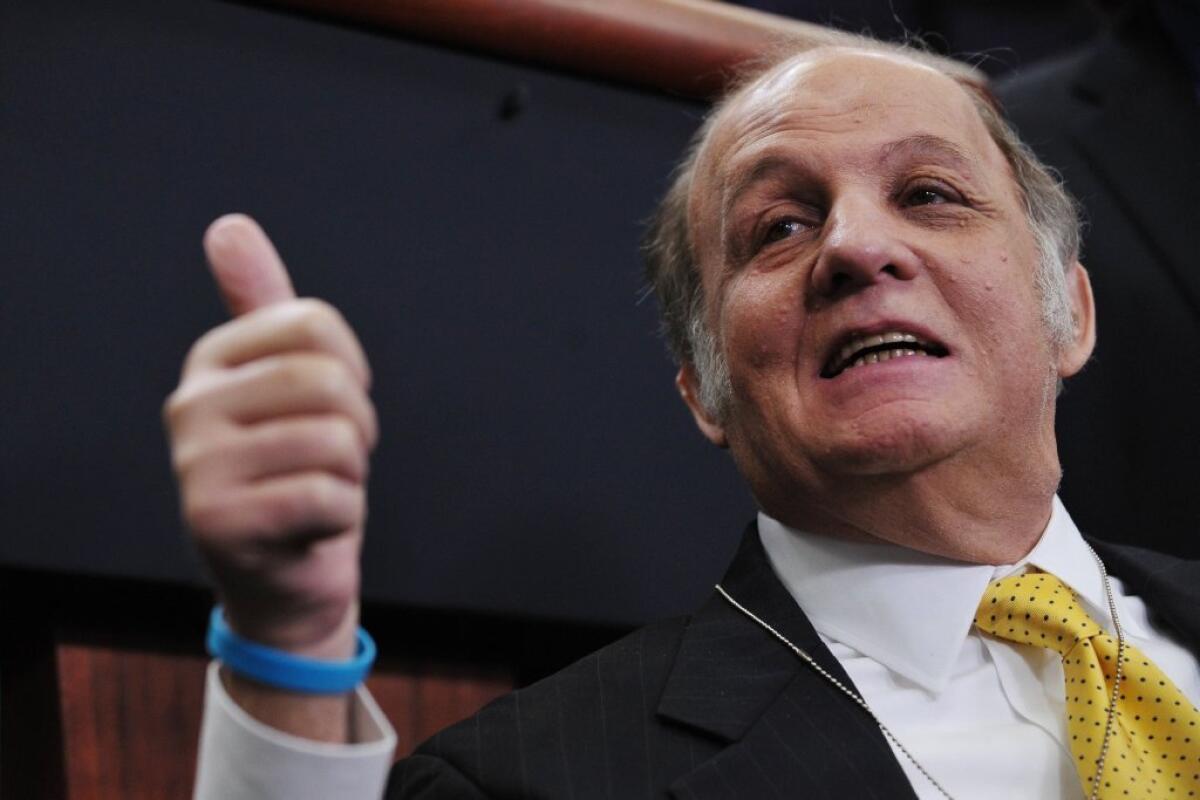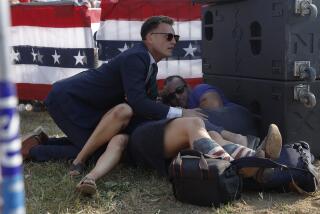Opinion: James Brady and the case for gun safety laws

- Share via
Jim Brady spent more than 30 years in a wheelchair, but he was one of the tallest men in Washington.
The press secretary to Ronald Reagan was gravely wounded in the gunfire that also struck the president as he was leaving a Beltway hotel only a couple of months after his 1981 inauguration.
Brady, who died this week, became the the centerpiece of the Brady Campaign Against Gun Violence. Nothing put across the message for gun laws more vividly than the sight of this man rolling into a meeting, a Senate hearing, a rally, partly paralyzed and hesitant of speech but passionate of purpose. Until Arizona Rep. Gabrielle Giffords, Brady was the nation’s most visible and vocal victim/advocate on gun control matters.
When he was questioned during a 1989 Senate hearing about a gun purchase waiting period being an inconvenience for gun buyers, he retorted, “I need help getting out of bed, help taking a shower, and help getting dressed and — damn it — I need help going to the bathroom. I guess I’m paying for their convenience.”
In spite of his passion and purpose, the spatter of gunfire outside the hotel in 1981 didn’t move the needle on federal gun laws like the ones that had allowed the shooter, John Hinckley Jr., to buy a pawnshop Saturday Night Special cobbled together from foreign-made bits.
Nothing happened for a dozen years, until 1993, when President Clinton signed the Brady Bill, mandating licensed dealers and waiting periods and background checks for buying a handgun.
After President Kennedy was assassinated by a man using a mail-order rifle in 1963, nothing happened. It took two additional political assassinations — of his brother, presidential candidate Robert F. Kennedy, and of the Rev. Martin Luther King Jr. — before the Gun Control Act of 1968 was passed.
The Stockton playground shootings of 1989 and the 1993 San Francisco high-rise shootings persuaded Congress to pass an assault weapons ban and to outlaw a number of other weapons. The assault weapons ban expired 10 years ago, and Congress has refused to extend or renew it since.
Then came the Columbine, Colo., school massacre in 1999 — and nothing happened.
Virginia Tech, 2007 — the first major federal gun law in more than 10 years added 2 million people to the federal background check database, among them the mentally ill, although the Justice Department found that only 4.3% of homicides are committed by people with histories of mental illness.
Gabrielle Giffords, 2011 — nothing happened, despite ongoing Democratic and Republican congressional efforts. No, that’s not quite true. A month after the shooting, nearly half of Arizona’s state legislators did sponsor a successful bill to name an official state gun.
The Aurora, Colo., movie theater shootings — no federal gun law changes.
The Newtown, Conn., massacre of 26 schoolchildren and teachers, 2013 — nothing.
So the recent marquee massacres haven’t changed federal gun laws in any real way. Neither has the daily abattoir of gun deaths in the United States, more than half of them suicides, and, nearly twice a week, some child, often shot dead by some other child with a gun that was left within reach. Yet not even the merest child-safety federal gun legislation, like trigger locks — laws that don’t restrict anyone’s right to buy a gun — can get passed.
For 30 years, James Brady put a face to gun violence in this country. Every day, 80 or 90 more faces join his. Whose face will be what Brady wished for — the last of them?
Follow Patt Morrison on Twitter @pattmlatimes
More to Read
A cure for the common opinion
Get thought-provoking perspectives with our weekly newsletter.
You may occasionally receive promotional content from the Los Angeles Times.











